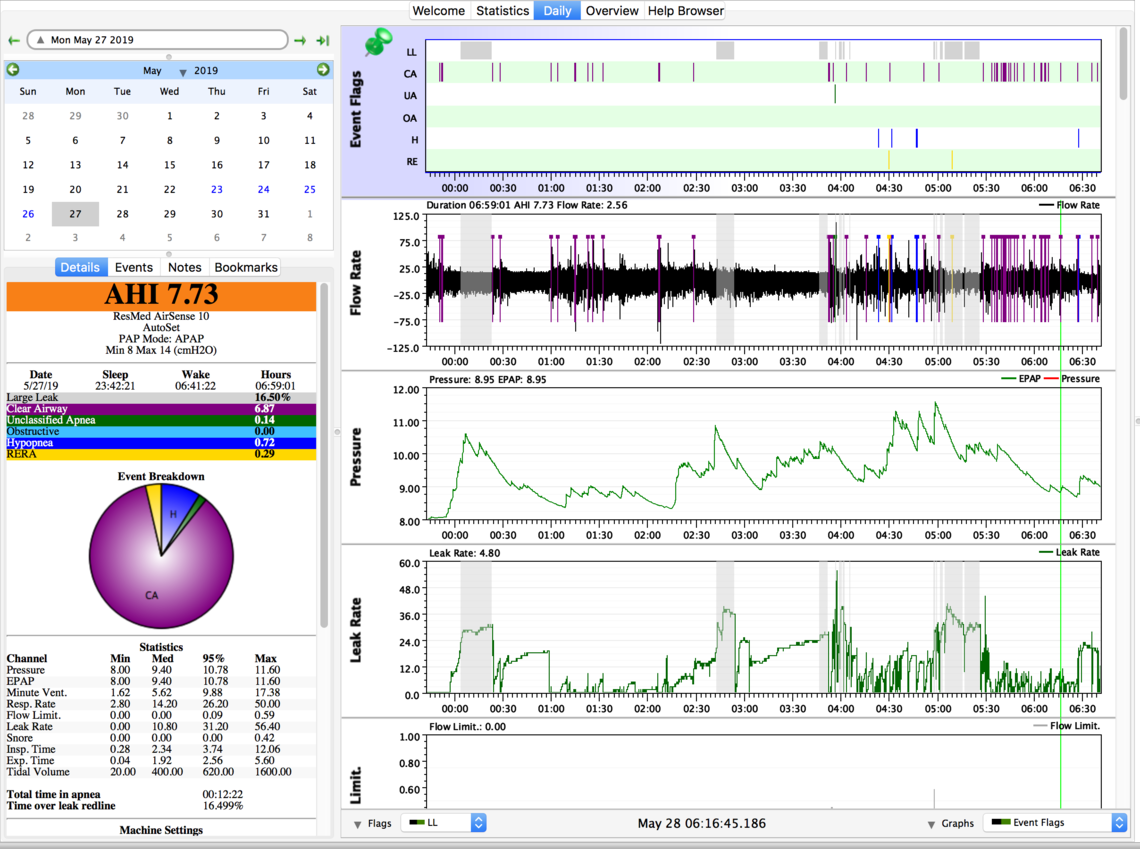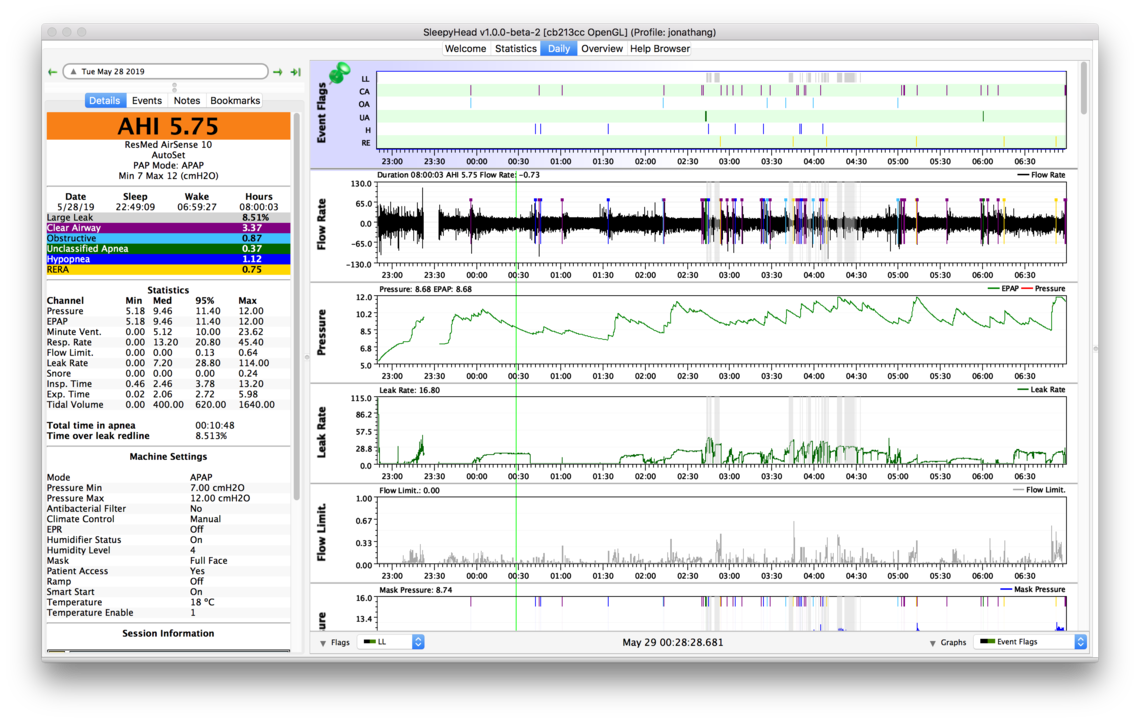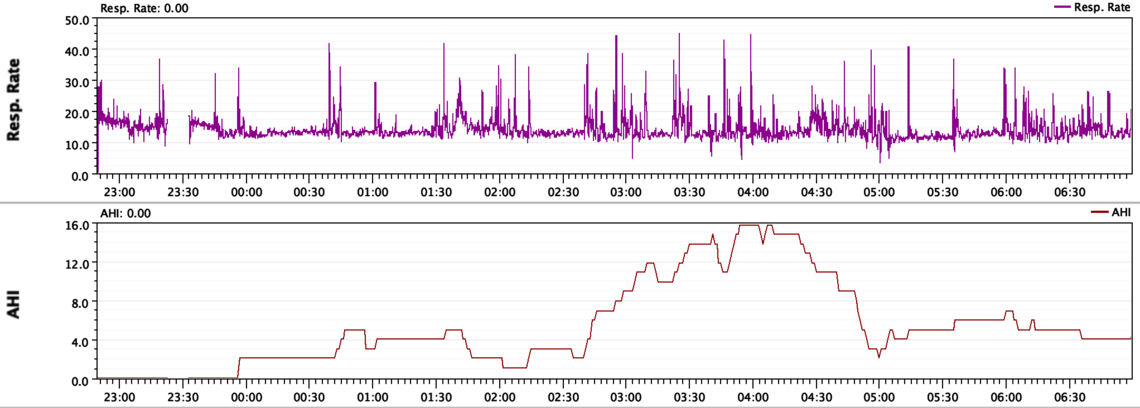I've been using my AirSense 10 since last Thursday. I'm using the Dreamwear FFM, but I believe my FF cushion should be a small instead of a medium. Working on getting that resolved. I only have data on my SD card from last night, will continue to review nightly results using Sleepyhead.
I remember waking up at/around 5:00 with a large leak. I could make the leak go away if I tensed my jaw. As soon as I relaxed it though (as if sleeping), the leak would return. I tightened the straps and it seemed to go away. This basically happens every night - I'll wake up to a leak and have to tighten the straps on the mask.
My in home sleep study AHI was 18 and then my second in home sleep study was 12.8. The doctor prescribed settings of "5 to 12", although I bumped it to "8 to 12" because the first night I kept waking up gasping for more air. I feel better than I did a month ago, but I'm nowhere near where I want to be. 36 year old male, BMI of 28 but that's because I have an athletic build (and sub 15% bodyfat).
What should I adjust based on the data below? What am I looking for? I'm seeing a lot of "clear airway" apneas, is that because I adjusted the pressure?

Welcome to the forum. First off, I need to make you aware that I am not a medical professional. I have monitored my apnea with SleepyHead now for over a year, and my wife's apnea for 4 years. Here are my thoughts on you daily report, just based on personal experience.
First, you have zero obstructive events. That indicates you are not suffering from lack of pressure, and may in fact have too much pressure. Your mask leaks are high at times, but not real excessive, and not your biggest issue, which is the high number of CA or central events.
If you have taken the responsibility to adjust your own pressures I would suggest reducing your minimum pressure to 7 cm, and your maximum to 10 cm. The maximum may have to go lower than that, but that would be a start.
For going to sleep comfort with the AirSense 10 I like to use the AutoRamp feature. To use that turn it on in the clinical menu, and set the ramp start pressure to 7 cm as well. I also like to use EPR set at 3 but set for ramp only. Set this way the machine will give you 7 cm on inhale and 4 cm on exhale as soon as you start the machine. Then when you go to sleep the machine will stop the EPR and you will be at your minimum 7 cm. Using the AutoRamp with EPR set to Ramp Only helps a lot with the gasping for air issue.
With SleepyHead, I suspect you are using a Mac? You can show a little more useful data if you click on that little triangle beside the date to hide the full month calendar. You can also set it to not show the big pie chart which uses up space too. On a PC it is File, Preferences, Appearance, and then uncheck the "show event breakdown pie chart". This lets more useful information display on the Daily report screen.
This said, you may need significantly less pressure than even the settings I suggested. You may want to discuss the issue you are having with your sleep doctor or technician. It appears you are quite sensitive to pressure induced central apnea. It may be possible that you will be better off with a fixed pressure (which the AutoSet can do) of 7 cm or perhaps even less. But, you can try the lower settings I suggested and if you keep getting high CA frequency and zero to low OA, then keep reducing the max pressure. That is the way I would do it for myself, and in fact have done so. I am sensitive to CA events and used to have the machine in Auto with pressures up to 15 cm. Now it is set at a fixed 11 cm.
Hope that helps some,
Your machine is not designed to treat Central Apnea. With CPAP/APAP machines Central Apnea is "treated" by avoiding it.
Typically, in those that are sensitive to it, something that both you and Sierra share, increasing pressure and increasing Pressure Changes either algorithmically with APAPs or with EPR/Flex increases Central Apnea or Clear Airway. Thus carefully and methodically lowering pressures is done to lessen Central Apneas ending when a comfortable balance is found.
If yours are Treatment-Emergent there is a good chance that they will go away as your body adjusts to them. This usually takes 2-3 months.
Thank you for the detailed replies, guys! After reading some of the other comments here, I had a sneaking suspicion that adjusting my pressure up from the prescribed settings was causing the CA's. I adjusted my pressure down to min 7, max 12 (from min 8, max 14) last night. While I had a lower overall AHI (5.75 vs. 7.73), I again woke up around the 4:00am - 5:00am mark with a leaking mask and a feeling of being unable to breathe.
Further, later in the morning (around 6am), I noticed myself waking up gasping.
I've attached screenshots (removed the chart, shrunk the calendar!) below. I'm going to try a fixed pressure setting of 7 or 8 tonight and see what happens. Separately, I noticed some oddities with my "Resp. Rate" chart. I believe you referenced this elsewhere Sierra with a comment along the lines of "40 is panting" - I'm spending what appears to be significant time above 15, ranging up to 45... any idea what the heck that is about?


I think I would try a minimum of 7 and maximum of 8 cm. It is a tight range but it will give your machine a little room to change pressure and you will see what it wants to do.
Yes, your leak rate is a little high for a full face mask. Especially if you end up with a lower pressure range or low fixed pressure you may want to consider a nasal pillow mask like the ResMed P10 or the F&P Brevida. They tend to be more comfortable, but they can get moved off your face too. I don't think the mask is your biggest priority now, but it is a problem you will have to address.
If you set up the AutoRamp, initial ramp pressure equal to your minimum pressure, EPR at 3, and Ramp Only, that will not only let you get to sleep more comfortably, but it will give you an option if you wake up in the night and cannot get back to sleep. Just disconnect the mask and turn the machine off for a couple of minutes so it will restart the ramp.
Not sure about the high respiration rate. It might be due to oxygen saturation degrading. One thing you could look at is an expanded view of those CA events to see what they look like when they happen in quick succession as they appear to. Just use the up/down and left/right arrows, or click on the area of interest repeatedly to expand the scale so you can see individual breaths. It can give some clues as to what may be causing the CA events.